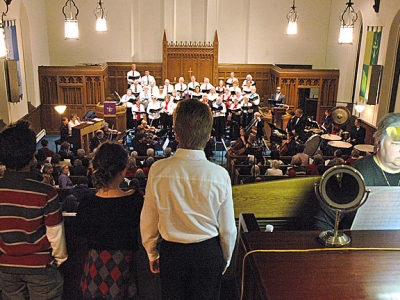2010 projects may include zoning update
- Published: February 18, 2010
A zoning code update. Safety improvements and upgrades for the skate park. Energy improvements for Village buildings.
These are some of the potential Village capital projects for 2010 presented by Village Manager Mark Cundiff at a Council budget work session on Tuesday, Feb. 9. The meeting, the first of three special Council budget meetings, was discussion only, and no decisions were made. The second special meeting, on the utility funds, will take place on Tuesday, Feb. 23, at 7 p.m. in Council chambers. The third meeting, on the general fund, will take place on Saturday, March 6. Council will vote on the 2010 budget by the beginning of April.
Council’s challenge in planning the 2010 Village budget is balance, according to Council President Judith Hempfling, who emphasized that prudence is especially important in light of the upcoming replacement property tax levy. The current property tax levy will run out at the end of this year, and most Council members have stated that they hope to put on the ballot a reduced levy next time.
“It’s especially important how we balance our priorities if we have a reduced levy,” Hempfling said. “There are always things we can spend money on, but how are we making these decisions since affordability is a priority?”
The capital projects listed above are some of the largest to come out of the general fund, if approved.
The zoning code update, which is estimated to cost about $75,000, would involve hiring a consultant to review the existing code, recommend changes and provide a new code for consideration, according to Cundiff. A revised code could provide the Village with more flexible and creative options for infill development, Council members and developers have said.
“We need specialized help that we don’t have,” said Cundiff regarding the need for a consultant. “We need someone who can get to know Yellow Springs and what we’re looking for, cutting-edge things that would be a good fit.”
Council Vice-President Lori Askeland, who is Council’s representative to Planning Commission, agreed that a new code is necessary to achieve Council goals.
“As long as I’ve been on Council, this is the big block that needs to change,” she said.
Regarding the skate park, there are safety improvements, estimated to cost about $10,000, that need to be made, Cundiff said. Beyond that, the capital project list includes an upgrade estimated to require $50,000 to match an equal amount raised privately. This project would include removal of the stairs leading to the park from the bike path, which has been requested by an adjacent property owner, Cundiff said, stating that concerns have been raised about persons hanging around the park on the path who are not skaters, but who sometimes create problems.
“I’m torn on this,” Cundiff said, stating that the skaters are not the ones seeking the removal of the steps, and they are also not the ones who have in the past provoked concerns from the property owners. He wants to meet with the skaters to determine upgrades that will meet their needs, Cundiff said.
“We have to do something. This is one of the more actively used parks in town,” he said.
The energy improvements to Village facilities, estimated at $50,000, would continue the replacement of current street lights with more energy-efficient models, as recommended by the Energy Task Force. The money would go to the upgrade and not to that group, Karen Wintrow emphasized. Other general fund capital projects include an upgrade to the Village Web site to make the site more easily accessible, a project that Council has endorsed to enhance citizen engagement. That upgrade would cost about $10,000.
Several of the most costly capital improvements are various street projects, including $370,000 to the ongoing street resurfacing program, and proposed drainage improvements on Winter Street, at a cost of $130,000.
The amount of money necessary for street repairs is diminishing because the resurfacing program, funded by the 2006 property tax levy, is in its fourth year, according to Cundiff, who said that the street resurfacing program will soon “morph” into pavement management after the larger repairs are made. That program should allow streets to be used five to seven years before they need resurfacing again, he said.
A significant amount of the 2006 levy has been spent on street repairs, according to Hempfling, who asked the Village to be mindful of the promises made when the levy was passed. At that time, 49 percent of the levy revenues were to go for streets and 51 percent for human services. However, for the first several years after the levy passed, the use of levy funds was not specifically tracked, a situation that this Council became aware of only last year. While it’s difficult to make sure all past levy funds have been used precisely as promised, the Village is now clearly linking levy revenues with promised expenditures and will continue to do so, Cundiff said.
The Feb. 9 meeting included capital projects in the utility systems, such as the repair of a “bottleneck” in the water system in the south end of town, which will be funded by recent water rate increases. Other proposed projects include an options study for improvements to the Sutton Farm crew building, funded by the facilities improvement fund, and upgrades to the train station, also funded by the facilities improvement fund. Several wastewater treatment plant projects are also planned, to be funded partly by federal stimulus monies and state grants.
For a complete list, go to http://www.yso.com and click on Council, then the Feb. 9 special meeting.
The Yellow Springs News encourages respectful discussion of this article.
You must login to post a comment.
Don't have a login? Register for a free YSNews.com account.

Parkinsons.jpg)













No comments yet for this article.